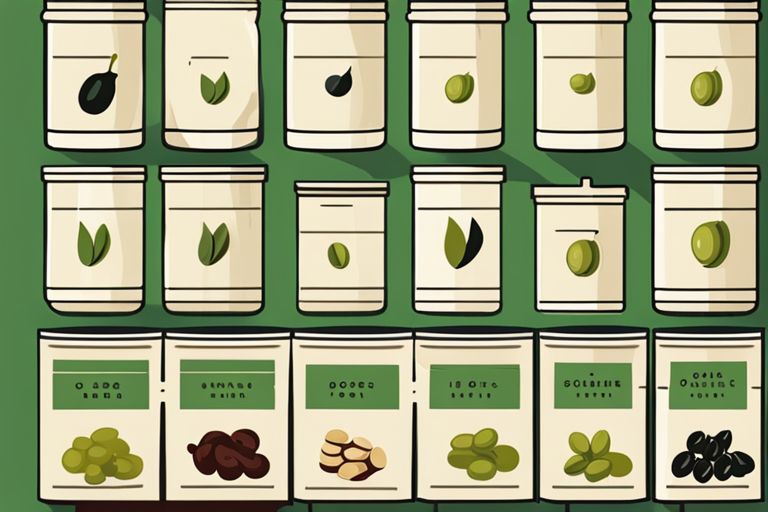
The Ultimate Guide to Olives Expiration Date
Get Your Free Food Safety Cheat Sheet
30 most common foods with instant answers. Print it and stick it on your fridge—completely free!
The Ultimate Guide to Olives Expiration Date
Olives are a popular and versatile ingredient used in various cuisines around the world. Whether you enjoy them in salads, on pizzas, or as a standalone snack, olives add a unique flavor profile to dishes. However, like any other food item, olives have a limited shelf life. In this comprehensive guide, we will explore everything you need to know about olives' expiration date, how to store them properly, and tips to ensure their freshness.
Understanding Olives Expiration Date
What is the expiration date of olives?
Olives typically come with a "best by" or "use by" date on the packaging. This date indicates the time frame during which the olives are expected to be at their peak quality in terms of taste and texture. However, it's essential to note that this date is a guideline, and olives may still be safe to consume after the expiration date if stored properly.
Factors that affect olives' shelf life
Several factors can impact the shelf life of olives, including:
- Packaging: The type of packaging can influence how long olives stay fresh. Sealed containers or cans tend to preserve olives better than those stored in open jars.
- Storage conditions: Proper storage is crucial for extending the shelf life of olives. Exposure to heat, light, and air can accelerate spoilage.
- Type of olives: Different varieties of olives may have varying shelf lives. For example, black olives typically last longer than green olives.
How to Properly Store Olives
Refrigeration
Storing olives in the refrigerator is the best way to keep them fresh for an extended period. Follow these steps for optimal storage:
- Transfer olives to an airtight container or resealable bag.
- Ensure the container is tightly sealed to prevent air from entering.
- Place the container in the refrigerator, away from strong-smelling foods.
Freezing
If you have a large batch of olives and want to extend their shelf life further, freezing is an option. Here's how to freeze olives:
- Remove olives from their original packaging.
- Place the olives in a freezer-safe container or bag.
- Label the container with the date of freezing.
- Thaw frozen olives in the refrigerator before consuming for the best quality.
Room Temperature
While refrigeration is ideal for preserving olives, they can also be stored at room temperature for a short period. If you choose to store olives outside the refrigerator:
- Keep them in a cool, dark place away from direct sunlight.
- Use them within a few days for optimal freshness.
Signs of Spoiled Olives
It's essential to know how to identify spoiled olives to avoid consuming them and risking food poisoning. Here are some signs that olives have gone bad:
- Unpleasant odor: Spoiled olives may have a sour or unpleasant smell.
- Mold: Any visible mold on olives indicates spoilage.
- Slimy texture: If olives feel slimy to the touch, they are no longer safe to eat.
- Off taste: Rancid or off flavors are a clear indication that olives have spoiled.
Conclusion
In conclusion, understanding olives' expiration date and proper storage methods is key to enjoying these flavorful fruits safely. By following the tips outlined in this guide, you can ensure that your olives stay fresh and delicious for as long as possible. Remember to check the expiration date, store olives in the refrigerator or freezer when needed, and always discard any olives that show signs of spoilage. Enjoy your olives responsibly and savor their unique taste in your favorite dishes!

Authoritative Food Safety References
These agencies and university labs inform every tip and health precaution we publish.
USDA FoodKeeper – Cold Storage Guidelines
Official refrigerator, freezer, and pantry timelines maintained by the U.S. Department of Agriculture.
Visit USDA FoodKeeperFDA Produce Safety Rule & Grower Guidance
Field-to-fridge handling practices that prevent contamination of fruits, vegetables, and leafy greens.
Visit FDA Produce SafetyCDC Foodborne Illness Prevention Hub
Surveillance-backed guidance on pathogens, symptoms, and steps to reduce foodborne illness risk.
Visit CDC Food SafetyUC Davis Postharvest Technology Center
University research detailing optimal storage atmospheres for produce after harvest.
Visit UC Davis PostharvestPenn State Extension – Home Food Preservation & Safety
Peer-reviewed extension bulletins on safe canning, chilling, and reheating practices.
Visit Penn State ExtensionQ: Can I eat olives after the expiration date?
Q: How should I store olives to extend their shelf life?
Q: Are olives safe to eat if they are discolored?
Q: Can I freeze olives to make them last longer?
Get Your Free Food Safety Cheat Sheet
30 most common foods with instant answers. Print it and stick it on your fridge—completely free! Want more? Upgrade to the complete guide with 70+ foods.
Scan your food directly and get instant safety info using our AI-powered camera feature.